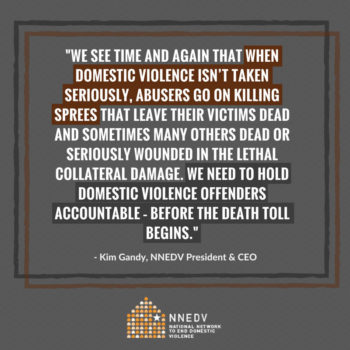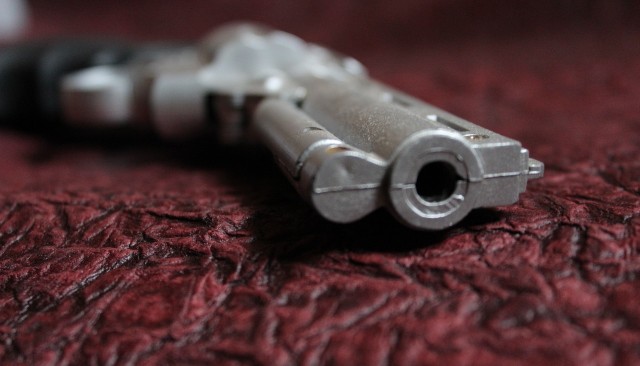Guns and Domestic Violence are a Deadly Combination
April 12, 2017
Lethal school shooting leaves three dead in San Bernardino County
On Monday afternoon, known domestic violence offender Cedric Anderson reportedly opened fire in an elementary school. Police are now referring to this crime as a “murder-suicide” – a term which fails to acknowledge the deadly consequences of domestic violence and the wider impacts in this case: one dead child and one child seriously injured. [1] Abusers often make specific threats to harm their victims, and those threats are frequently not taken seriously (see: Elonis v. United States).
Domestic violence is about the abuser exercising power and control over the victim. Even after a victim breaks free from an abuser, she is not immediately safe. Abusers are often deadliest when victims try to leave or have recently fled the abuse. [2] One-fifth of homicide victims with restraining orders are murdered within two days of obtaining the order, and one third are murdered within the first month. [3] After leaving an abuser, victims must continue to make specific plans for their safety, sometimes for the rest of their lives.

“Even for victims who leave, their safety isn’t automatically secured,” said Kim Gandy, President and CEO of the National Network to End Domestic Violence (NNEDV). “Although it is counter-intuitive, sometimes not leaving is the safest thing to do at a given moment. One of the most critical services provided by local domestic abuse programs is safety planning with the victim – preparing and leaving in a way that poses the least risk.”
Guns and domestic violence are a deadly combination. The mere presence of a gun increases the risk of domestic violence homicide by 500 percent. In 2014, more female homicide victims were killed with a firearm than with all other weapons combined. [4]
“Abusers’ access to firearms is a serious concern for victims of domestic violence and their communities,” continued Gandy. “We see time and again that when domestic violence isn’t taken seriously, abusers go on killing sprees that leave their victims dead and sometimes many others dead or seriously wounded in the lethal collateral damage. We need to hold domestic violence offenders accountable – before the death toll begins.”
NNEDV supports common sense firearms proposals that would reduce perpetrators’ access to firearms, including expanding the law to prohibit stalkers and abusive dating partners from possessing firearms; requiring firearms removal at the time temporary orders of protection are granted; and improvements to the criminal background check system. Additionally, NNEDV urges lawmakers to increase resources for emergency shelter, housing, legal remedies, economic opportunities for survivors, and training for first responders.
—
[1] CNBC, “Apparent murder-suicide shooting at San Bernardino school leaves 3 dead, including student, teacher,” (April 10, 2016). http://www.cnbc.com/2017/04/10/multiple-people-shot-at-san-bernardino-elementary-school-official-says.html
[2] J. C. Campbell, J.C.,Webster, D., Koziol-McLain, J. and et al., Risk Factors For Femicide in Abusive Relationships: Results From A Multi-Site Case Control Study, American Journal of Public Health, 93(7), 2013.
[3] Vittes, K. A. & Sorenson, S. B. (2008). Restraining orders among victims of intimate partner homicide. Injury Prevention, 14(1), 191-195.
[4] Violence Policy Center, “When Men Murder Women: An Analysis of 2014 Homicide Data,” (September 2016). http://www.vpc.org/studies/wmmw2016.pdf





